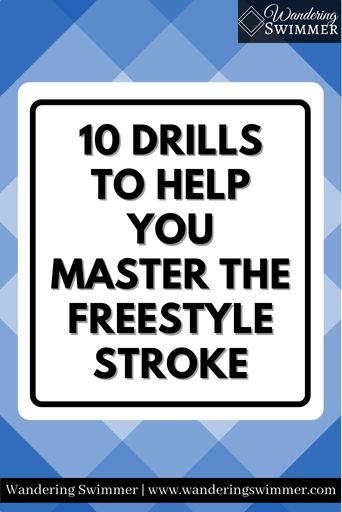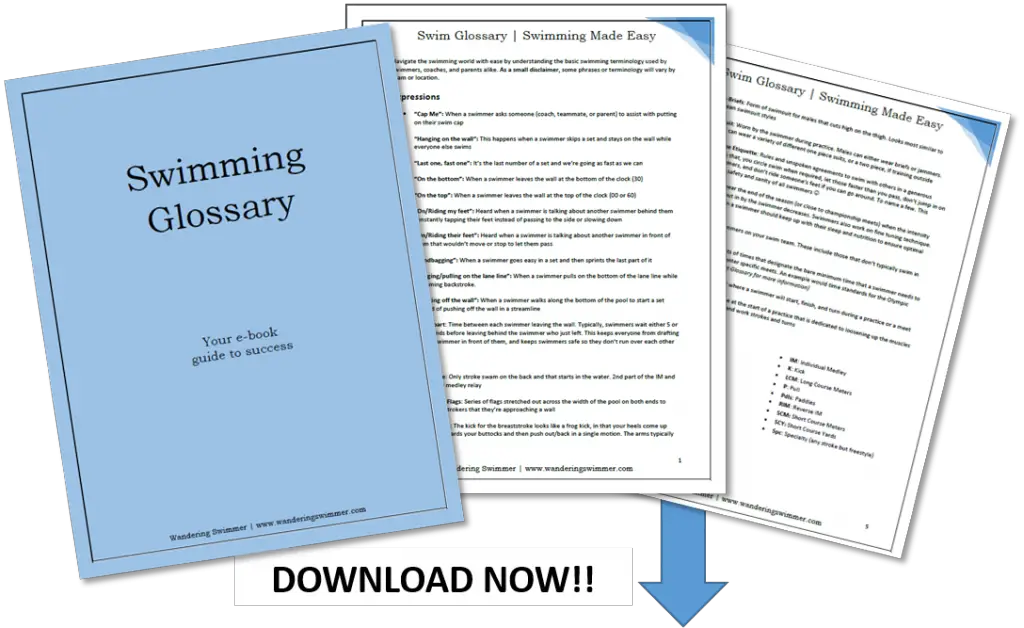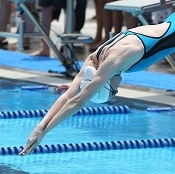Learning the stroke portion of the freestyle (or the front crawl) should start with progressive drills that help you learn and build your freestyle stroke.
Each of these freestyle stroke drills builds upon the other so that you can develop the base stroke and go from there.
If you’re ready to better your freestyle stroke, here are 10 drills to help you master the freestyle stroke.
Disclosure: This post may contain affiliate links, meaning we earn a small commission at no cost to you if you purchase something through one of our links. As an Amazon Associate, we earn from qualifying purchases. Please check out our disclosure page for more information.

10 Freestyle Stroke Drills
We will note that you should have a basic understanding of freestyle/the front crawl. Drills only work if you know the basics and build from that.
If you haven’t done so already, we highly encourage you to read our earlier articles: Beginner’s Guide to Swimming Freestyle and The Freestyle Stroke and Arm Movement.
These cover the basic movements of the freestyle stroke and serve as the building block for these freestyle stroke drills. You need to understand the motions and movements of the stroke before you can start working the drills.
We also encourage you not to move on to the next set of drills until you’re comfortable with the drill you’re currently on.
Most of these drills can be completed without any gear or equipment. However, they can make it easier to get the feel of the drill down. Especially if you don’t know how to side-breathe just yet.
If you can’t side-breathe yet, we suggest using a snorkel to keep you from stopping or lifting your head to breathe. Snorkels are a great way to allow yourself to focus on working your stroke without messing up your body alignment to get air.
At most, these drills require a kickboard and perhaps a set of fins to make some of the drills easier to keep your hips and shoulders high in the water, and aid in your kick.
1. Practice on Land
This may not be the first freestyle stroke drill you imagined but it’s a fantastic starting point for new swimmers learning how to swim freestyle. Practicing the motions of the freestyle stroke on land is easier because the air resistance is much less than water resistance.
It also helps you familiarize yourself with the motion before putting that motion into practice in the water. And while you may think it’s silly, even competitive swimmers practice their strokes on land!
While doing this drill, watch how your arms move to ensure you’re not dropping your elbow or that your entry isn’t too tight. It will feel different practicing the motions on land compared to the water but it’s still good to get the feeling before going into the water.
2. Single Stroke With a Kickboard Drill
This freestyle stroke drill is not just good for learning the stroke, but it’s also a good drill for learning to side-breathe, too! Because it forces you to slow down, you can focus more on each piece of your stroke and keep your entry shoulder’s width apart.
To start, you’ll need a kickboard. Place it in the water in front of you with the long side of the board facing you. Hold onto the board at either end on the long side so that your arms are shoulder-width apart.
Push off the wall with your body facing the bottom of the pool and start kicking. Once you have your balance in the water, begin to take your strokes. Do this by:
- Keep one hand on the kickboard (left for this example) and let the other hand release its grip on the kickboard (your right hand)
- Bring your right down through the water to start the ‘catch’ portion of your stroke
- Continue through the ‘pull and exit’ pieces of the freestyle stroke
- Following the ‘recovery’, your hand should grab the edge of the kickboard once more
- Repeat with the same arm!
You must keep a constant kick throughout this drill to keep your hips up in the water. Otherwise, you may find it harder to take each stroke.
You’ll also need to engage your abdominal muscles to keep yourself balanced. Doing this will help keep you from wobbling all over the place! 🙂
Related article: A Quick Guide to Body Position in Freestyle
Try to slow your freestyle stroke down so you can feel the water as you’re catching and pulling it. It’s helpful for this drill to have a snorkel so you can go the length of the pool without stopping for breath.
We’ll also note that even with the kickboard in front of you, your hips and shoulders will still rotate with each stroke you take.
Go down the pool with one arm and then come back using the other arm. This will allow you to work both arms and get a good feeling for the rotation in your stroke.
3. Full Stroke With a Kickboard Drill
This next freestyle stroke drill is almost similar to the previous drill. Except for this drill, you’ll use both your arms to take a full stroke cycle.
Similar to the earlier drill, you’ll start with your kickboard in front of you and your body flat in the water. Grip the edges of the board, start kicking, and begin to take your first stroke.
This time though, when your right hand (for this example) grabs the kickboard after the recovery piece, it will stay on the kickboard. Your left hand will then leave the kickboard and start the catch piece of the stroke.
Related article: 7 Drills to Practice Side Breathing in Freestyle
It will be very broken and slow freestyle as your stroke slows each time your hand comes back to the kickboard to switch arms. But this slow motion helps you feel the catch and pull of the water during your stroke.
And because you’re moving slower, you can watch your hand and arm during the catch and pull as they leave the kickboard. See if your hand is going too far past your shoulder on the catch piece or too narrow.
This drill also helps force you to keep your stroke shoulder’s width. When you bring your arm around to grab the kickboard, you should be reaching for the edge/corner. If you’re grabbing the middle section, your stroke is too tight!
Again, having a snorkel and fins can help as they can make it easier to focus on your stroke without needing to worry about breathing or excess kicking.
4. Single Arm Stroke
For this drill, you may find it easier to start with swim fins until you’re comfortable enough with the drill to go without.
Related articles:
As the name suggests, this drill only uses one arm during the freestyle stroke. It will be very similar to the single-arm drill stroke with a kickboard. But this time, you’ll be going without a kickboard.
- Start with one arm down at your side (left for this example)
- Use only your right arm for the stroke
- Go down the length of the pool using this arm
While doing this freestyle stroke drill, you should still feel your body rotating. Especially if you’re turning your head to side-breathe. Even if you’re using a snorkel, you should still have rotation.
If you don’t use a snorkel (and we suggest that you build up to not using one!), try breathing to the side not pulling water. Which would be the side where your arm is down at your side.
We like recommending breathing to the opposite side of the pulling arm as it works better rotation. It can also make the stroke a bit easier.
During your drills, remember to keep kicking and take your time. Set your hand so that you can catch and pull the water with each stroke. Only working one arm at a time can help you find your weak and strong arms, and help you feel the water better.
5. Single Arm Stroke Pattern Pull
It may have a complicated name but it’s actually an easy freestyle stroke drill, we promise!
Building on the last few drills, you’re still using a single arm for each stroke. However, this time, you’ll alternate arms every few strokes.
- Start with your single-arm stroke drill and take 3 to 5 freestyle strokes with one arm
- After your set number (5 for this example), switch to the other arm
- Repeat the same number, (5 strokes) with the opposite arm
- Switch back to the arm you started with
Simple overall but it’s a great way to build into taking a full stroke cycle!
As you’re reaching the last stroke number, finish with your stroking arm down at your side at the same time your opposite arm is rotating to exit and recover. One of the main focuses of this drill is getting the timing down between each arm stroke.
More Content for You: Why Do Swimmers Use Kickboards?
It will take some time to get into the rhythm of the stroke if you’re just starting. And that’s okay! Take your time and focus on each stroke. This drill may take a bit longer to feel comfortable with but it’s an important one not to rush through.
6. Single, Full, Single Stroke Pattern
Again, another complicated name for a rather simple drill. Once more, this drill will build on the previous one.
Like the previous drill, you’ll start with a single-arm stroke but this time, take just 3 strokes with your first arm.
- Once you hit your third stroke, take your next stroke with your opposite arm
- Take 5-7 strokes of regular freestyle strokes (use both arms)
- After you finish your set number, you should finish on your opposite arm
- Take 3 more single-arm strokes with this arm
- Repeat the 5-7 strokes of regular freestyle strokes
This drill will work your rotation as you alternate between single-arm and full-cycle strokes. We like that you get a chance to focus on one arm at a time before and after the full-cycle strokes to help you feel the water and stroke technique.
You may want to use fins at the start of the drill to help get a better rotation. Don’t forget to swim through the core and rotate with each stroke you take.
More Content for You: Basic Pool Etiquette: 15 Ways to Share the Pool
7. Head Up Freestyle
If you’ve read our other ‘how to swim freestyle’ articles, you know that we’ve mentioned several times that swimming with your head up is bad. And it’s true!
But, doing so for drills and in short bursts is okay. Mainly because it’s for a short time and it’s used to help watch your stroke to help correct hand entry.
- Tilt your head up in the water so you’re looking slightly up (your head should still stay in the water, don’t lift it out)
- Watch where your hand enters the water
- Do this for about five strokes and then lower your head back into a neutral position
- Take 5-7 more regular strokes and tilt your head again for five more strokes
When you watch for your hand entry, you’re looking to see where your hand enters the water. It should be out in front of you and almost in line with your face.
Using your right hand as an example, if your hand is crossing left in front of your face, then your entry is too tight. Think of a line extending out from the tip of your nose and through the water. Your hands shouldn’t be crossing that center line to enter the water.
On the other side, if your hand is entering wider than your shoulder, then your entry is too wide. Much like the line from your nose, imagine a line from your shoulder. Your hand shouldn’t be entering past that line.
More Content for You: How Much Does Swimming Cost?
8. High Elbow Recovery Drill
To work a freestyle recovery that uses a high elbow recovery, this drill is for you! As the name implies, you’ll hold a high elbow during the recovery portion of the stroke.
You can do this one of two ways:
- During the recovery, drag your thumb along your side and up through your rib cage
- Or, allow the tips of your fingers to drag along the surface of the water
Both of these options will force you to keep your elbow high during the recovery piece of your front crawl stroke.
More Content for You: 8 Best Swim Parkas for Swimmers
9. Double Recovery
This drill really works the timing and the power of the recovery of one arm at the same time the other arm is catching and pulling the water. It does take some time to learn but once you master it, you can feel the acceleration as the stroke propels you through the water.
- Start with one arm out in front of you (right for this example) and hold it in a catch position
- Your left arm should be back behind you
- With your left arm, start your recovery piece of the stroke
- When your fingertips touch the water, swing your arm backward in a reverse recovery motion
- You should stop about halfway, right around your shoulder
- Bring your left arm forward again to complete the recovery stroke and let your hand enter the water
- At the same time, your right hand should be catching and pulling so it finishes behind you
- Repeat with your left arm in front and use your right arm to recover
Not the easiest of drills, we’ll admit. But it does help you work your timing and you can feel the rotation in your stroke.
If you don’t feel yourself surging forward at the final rotation stroke, your timing may be off. You also need to kick for this drill if you plan to get some oomph on the stroke. Add some fins to make this drill easier.
Related article: 11 Ways to Improve Your Freestyle Kick
10. Closed-Hand Freestyle
My favorite freestyle stroke drill! It’s simply regular freestyle but instead of keeping your palm open and flat, you close your hand into a fist. Doing this can help you feel the catch and pull of your stroke and force you to pull with your forearm.
Some swimmers like to hold onto a small ball, such as a tennis or racket ball, to help keep their hands closed. Other swimmers like to hold onto a coin to ensure they’re keeping a tight fist instead of a lax one.
If you don’t want to purchase anything, closing your hand into a tight fist works just as well!
Optional Gear to Use for Freestyle Stroke Drills
Aside from using a set of swim fins to work your freestyle stroke drills, you can also consider adding a pull buoy or a set of swim paddles.
Pull buoys will stop you from kicking and help keep your hips high in the water. Because you’re not kicking, you may find that you can focus specifically on your freestyle stroke. However, you may also have trouble with the buoy making you over-rotate at times.
To counter this, swim from your core and focus on the rotation of your body. If you feel yourself listing to the side, use your stroke to adjust your balance.
Swim paddles can be an extension of your hand and will help you feel the water. Not just that, but they can help provide quick feedback on your stroke.
Related articles:
- The 7 Best Swim Paddles for Swimming
- A Swimmer’s Review of FINIS Freestyler Paddles
- A Swimmer’s Review of Speedo’s Power Paddle Plus
Some paddles, such as the FINIS Freestyler Paddles will send your hand/arm all over the place if you’re not entering the water and pulling correctly. It can be incredibly maddening but the instant feedback can help you identify issues with your stroke.
Add either a buoy or paddle to your drills to take them to next level!
In Closing
Patience and correct timing are key in freestyle (and swimming as a whole). Work through each of these drills and don’t move on to the next before you’re truly ready.
As always, happy swimming!
Chevron
Bonus Content
Your Ultimate Swim Cap FAQ: While a swim cap seems simple, it can be confusing. To help, we’ve compiled a list of questions to help you sort through the confusion.
Can I Swim With Bad Eyesight?: Can you swim with bad eyesight? Bad eyesight may limit you from many things, but swimming isn’t one of them! Here’s 4 ways to swim with bad vision.

Want to Improve at the Pool?
Join swimmers and swim parents to receive my free newsletter and receive a free Swimming Glossary e-book as a thanks!
Every month you’ll receive tips and coaching to help you find success at the pool.
About

Chevron is a current competitive swimmer with almost 20 years of experience in the pool. And although she fell into the sport by accident in her high school years, she still trains daily and competes throughout the year. She’s committed to providing guidance to all levels of swimmers and believes that everyone should know how to swim.